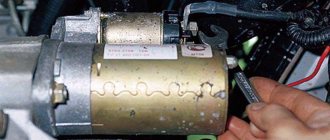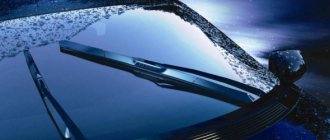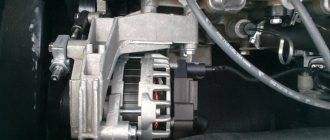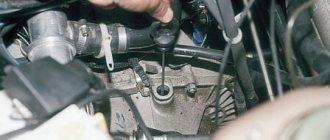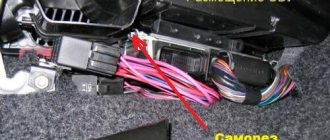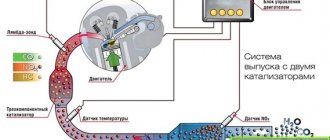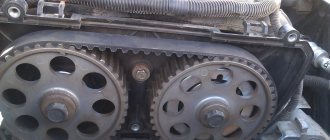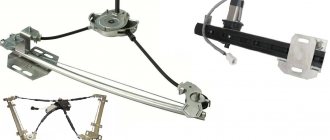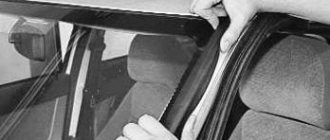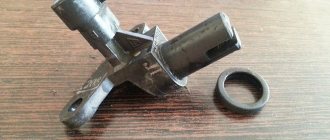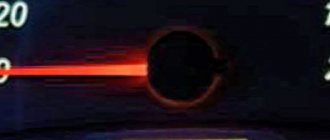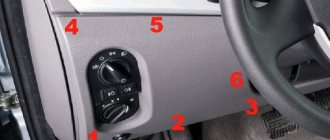Lada Kalina - fuse and relay blocks
Lada Kalina 1st
generation was produced in 2004, 2005, 2006, 2007, 2008, 2009, 2010, 2011, 2012 and 2013 under internal serial numbers
VAZ-1117, VAZ-1118, VAZ-1119
with sedan bodies , hatchback, station wagon. In this article we will show a description of fuses and relays of the 1st generation Lada Kalina with block diagrams and photographs. Note the fuse responsible for the cigarette lighter.
p, blockquote 1,0,0,0,0 –>
p, blockquote 2,0,0,0,0 –>
The design of the blocks and the purpose of the elements in them may differ from those presented and depend on the year of manufacture and level of equipment of your Lada Kalina. Check the description with yours, printed on the back of the protective cover, or other technical documentation.
Functions of the Kalina fuel pump relay and its replacement
The Kalina fuel pump relay is an important element for ensuring stable operation of the car. The internal combustion engine is the main unit for the movement of road transport. With the advent of electric vehicles, the share of cars with internal combustion engines is decreasing, but the vast majority will be provided with cars powered by hydrocarbon raw materials for the coming decades.
For stable operation of the flaming engine of any car, including the Lada Kalina, a stable supply of a sufficient amount of fuel is necessary.
The main element of the fuel system on Kalina is the fuel pump. The fuel tank on the Lada Kalina is located in the rear of the body, therefore, the delivery of gasoline through the supply pipes to the injector sprinklers must be constant and forced.
Other elements of the car's fuel system, in addition to the tank and fuel pump, are a fine filter and fuel supply pipes.
Engine control unit
This unit is located in the center console.
p, blockquote 13,0,0,0,0 –>
The fuses responsible for engine operation are located on top under the protective cover.
p, blockquote 14,0,0,0,0 –>
Photo - diagram
p, blockquote 15,0,0,0,0 –>
p, blockquote 16,0,0,0,0 –>
Designation
p, blockquote 17,0,0,1,0 –>
- Diagnostic connector
- 15A - Main relay circuits (winding of the cooling system electric fan relay, canister purge valve, air flow sensor, speed sensor, oxygen concentration sensor, ignition coil)
- 15A - Fuel pump, viburnum fuel pump fuse.
- 15A - Constant power supply circuits of the controller (ECU)
The relays are located in the lower right part of the console, where the fuses for the electric cooling fan are also attached.
p, blockquote 18,0,0,0,0 –>
p, blockquote 19,0,0,0,0 –>
Scheme
p, blockquote 20,0,0,0,0 –>
p, blockquote 21,0,0,0,0 –>
The diagrams do not fit or you own a different generation of the model, study this description for the Lada Kalina 2.
And if you have any questions, write them in the comments.
The engine control circuits are protected by three fuses located under a cover in the floor tunnel lining. The system relays are assembled into a block and installed under the center console. The block additionally has a built-in fuse for the electric fan of the engine cooling system.
Replacing main fuses
1. We prepare the car for work and disconnect the wire terminal from the negative terminal of the battery.
2. Using a screwdriver, open and remove the cover from the center console.
Location of fuses and engine management system diagnostic connector in the floor tunnel trim
3. The fuse and relay mounting block contains tweezers for removing fuses from the socket. A faulty fuse is identified by a blown thread.
4. We install the fuse in place, connect the battery and make sure that the engine is working properly. Once the check is complete, replace the cover.
Recommendation
Sometimes the fuse thread remains intact, while its connection inside the fuse is broken. It is impossible to visually determine such a malfunction. In this case, you can assess the condition of the fuse using an ohmmeter.
Before replacing the fuse, the cause of the blown fuse must be determined and eliminated. To avoid failure of elements of the engine control system, do not install fuses with an increased rating or homemade ones.
Engine control system fuses
Position in the photo
Current strength, A
Protected Circuits
Main relay circuits (winding of the cooling system electric fan relay, canister purge valve, air flow sensor, speed sensor, oxygen concentration sensor, ignition coil)
Electronic control unit (constant power circuits)
Replacing the relay and additional fuse
1. We prepare the car for work and disconnect the wire terminal from the negative terminal of the battery.
2. Remove the right trim of the instrument panel console.
3. Using a socket wrench, unscrew the nut securing the relay block.
4. We remove the relay block from under the instrument panel console.
5. We move the block to the side for the length of the wiring harness.
Engine control system relay block and additional fuse: 1 - fuel pump activation relay; 2 — fuse for the electric fan of the cooling system (50A); 3 — relay for turning on the electric fan of the cooling system (low speed); 4 - main relay; 5 - cooling fan relay (high speed)
6. We remove the fuse for the electric fan of the engine cooling system. Check the fuse and replace the faulty one.
7. Similarly, we replace the engine control system relay.
8. We install the relay block under the center console and secure it with a nut.
9. We connect the battery and make sure that the engine control system is working properly.
10. At the end of the check, install the right trim of the instrument panel console.
Before replacing the fuse, the cause of the blown fuse must be determined and eliminated.
Guide to replacing the fuse box on Lada Kalina, explanation
The Lada Kalina has earned a reputation as a comfortable and reliable car. But, like all vehicles, it is not immune to various types of breakdowns. Quite often one or another electrical equipment fails. Some breakdowns are not critical, for example, the cigarette lighter does not work, but there are also those that can completely render your vehicle immobile.
This is, first of all, the failure of such an important component as the fuel pump. It is not always necessary to change the consumer in order to restore its functionality; very often it is enough to replace the fuse and the relay responsible for it to restore its functionality
Car Lada Kalina
Let's say right away that on the Lada Kalina car the electrical circuits are protected by electrical fuses and relays located in several compartments. For example, the fuse for the cigarette lighter is located in the main compartment under the panel, and the fuel pump is located in the additional compartment.
All blocks with electrical fuses are installed in easily accessible and convenient places, so changing and checking protective elements will not cause difficulties even for a novice car enthusiast.
Where is the fuse box?
The largest compartment, which houses most of the fuses and relays, is located on the left side of the instrument panel and is covered with a cover. The second, in which the elements responsible for the power unit control systems are located, is located in the lining of the floor tunnel. This is where the fuel pump fuse is located.
Location of the fuse and relay box on the Lada Kalina
Removal and replacement instructions
Replacing and identifying an unusable element in both the first and second blocks occurs in approximately the same way, so let’s consider the replacement process using the example of the one installed to the left of the dashboard.
Diagram on the back of the cover
Preparation
Be sure to remember that before you carry out work on electrical equipment, it doesn’t matter whether the cigarette lighter or the fuel pump has failed, the first thing you need to do is turn off the power to the system. To do this, turn off the engine and remove the negative terminal of the battery.
This video shows how you can quickly solve a problem with blown fuses on a Lada Kalina.
Steps
- We find the location of the block, it’s not difficult - the designers placed it on the left side of the dashboard under the cover.
- Open the lid.
- Using the diagram and table, we establish the location of the protective element we need.
- The block contains tweezers, with the help of which we extract the required element.
- Let's examine it.
- We check with an ohmmeter or lamp.
- If the spiral is burnt out, install a new one of equal value.
- We connect the removed battery terminal.
- We start the car.
- Let's see whether our consumer has earned money or not.
- If everything is in order, then the work is finished. If the consumer does not work or the electrical fuse has blown again, then everything is more serious. It may be necessary to check the circuit or dismantle the consumer and check it.
Layout of relays and electrical fuses
Explanation of the diagram shown in the photo.
Work with the block, which contains the element protecting the fuel pump and other elements responsible for the operation of the engine, is carried out in a similar way.
The protective element designed for 15 amperes, responsible for the fuel pump of the Lada Kalina, is designated F2 in the photo. To remove it, you need tweezers. All other work is carried out in the same way as in the large compartment.
Recommendations for use
- If you are a responsible car owner, then be sure to carry with you a set of electrical fuses of various ratings. Perhaps they will help you out at some point.
- Under no circumstances should you install wires or bugs. This can lead not only to failure of the electrical consumer, but also to a fire.
- Replacement only with an element of the same value is acceptable.
- Before work, do not forget to turn off the power to the system.
Video “Consequences of using low-quality electrical fuses”
This video shows what danger awaits the driver if he decides to save money and install a cheap Chinese electrical fuse. When a short circuit occurs, the conductive part in it does not burn out, but it simply begins to smoke. Such savings can lead to fire. Buy components and consumables only from reputable stores, otherwise you risk losing your car.
Basic information about the electrical circuit
The main fuse box in Kalina 2 is located to the left of the steering column and is covered with a plastic cover. On the inside there is a label with a printed diagram of the location of the parts.
Main unit located to the left of the steering column
Note that the “Lux” uses one set of relays, while in the “Normal/Standard” configurations it is slightly different. Relay “K5” is missing in both sets, and part “K6” may be missing in the “Standard” version. Fuse sets, in turn, may or may not contain element “F3” (automatic transmission fuse).
You can remove fuses only with special pliers, which you will find under the cover of the main unit.
Tips and tricks
When checking and/or replacing fuses and relays, it is important not to mix up the installation locations during reassembly. If the components in the fuse box are installed incorrectly, then various electrical equipment may become inoperable.
Finally, we would like to add that purchasing high-quality original parts guarantees their durability. The possibility that something in the pump circuit will burn out on its own for no reason is minimized. This recommendation fully applies to the fuel pump relay.
What functions does the fuel pump relay perform, signs of breakdown. Where is the fuel pump relay installed, how to properly check the fuel pump relay.
Why does the starter turn normally, but the engine does not catch and does not start? Main causes of malfunction, checking fuel supply and ignition systems. Adviсe.
How to determine why the fuel pump does not pump or works poorly. Fuel rail pressure, pump diagnostics. Wiring, relays, fuel pump fuses.
Diagnose faults that may indicate problems with the fuel pump. Self-check of the device, measuring the pressure in the fuel rail.
How to change a fuel pump. Location of the fuel pump, releasing pressure in the system, unscrewing the fuel lines, removing the pump, reassembling.
Mechanical and electric fuel pump, design and principle of operation of the device, types of pumps and main malfunctions, operating features
The gasoline pump is an integral part of the power system of a gasoline engine. In order for the pump in the Lada Kalina model to function uninterruptedly, there must be a working fuel pump relay in its electrical supply circuit.
The pump takes in a portion of fuel, which is traditionally located in the tank. In Lada Kalina, this container with gasoline is located in the rear of the body. There are special pipelines as lines that transport fuel not only to the ramp with injectors, but also back to the tank. Using a pump, a certain amount of pressure is generated in the fuel rail, which allows the injectors to spray gasoline in the form of a torch (the so-called “fog”). The fuel pump fuse also plays an important role.
Fuses, list and description
The electrical circuit of the Kalina-2 car can contain up to 38 fuses in total. The block installed under the hood contains 6 fuses designed for significant current. We, in turn, will consider the diagram of the main block:
All fuses in the electrical circuit of Kalina-2
- F1, 15A: ignition, injectors, power supply to the ECU and radiator fan relay;
- F2, 25A: power supply to the TsBKE unit and the front left door module;
- F3, 15A: electric drive of the automatic transmission, also power supply to the automatic transmission ECU;
- F4, 15A: power supply for airbag assembly;
- F5, 7.5A: speed sensor, brake pedal sensor, power supply to the instrument panel and ESD, ECM controllers, power supply to the automatic transmission selector, voltage on the windings of the unloading relay and the relay of the glass and seat heaters, power supply to the body electronics unit, washer switch;
- F6, 7.5A: power supply for automatic transmission electronics and reverse lamp relay;
- F7, 7.5A: voltage at the canister purge valve, at the phase sensor, mass air flow sensor, DC;
- F8, 25A: rear window heater and mirror heater circuit;
- F9, 5A: all “dimensions” on the right;
- F10, 5A: all “dimensions” on the left, license plate lights, keys;
- F11, 5A: rear fog lights;
- F12, 10A: low beam lamp, electric corrector for the right headlight;
- F13, 10A: low beam lamp, electric corrector for the left headlight;
- F14, 10A: high beam lamp on the right;
- F15, 10A: high beam lamp on the left;
- F16, 10A: “fog light” on the right;
- F17, 10A: “fog light” on the left;
- F18, 20A: seat heater circuit and cigarette lighter circuit;
- F19, 7.5A: ABS controller power supply;
- F20, 15A: signal;
- F21, 10A: fuel pump motor;
- F22, 15A: windshield and rear window washers, rear wiper;
- F23, 5A: power supply to the diagnostic connector, as well as to the instrument panel;
- F24, 7.5A: air conditioner motor-compressor clutch circuit, power supply to the air conditioner controller;
- F25, 7.5A: voltage at the brake pedal sensor;
- F26, 7.5A: ABS valve drives;
- F31, 30A: short-term switching on of high beams, power supply to the central bank, gear motor for front wipers;
- F32, 30A: heater fan circuit, power supply to the air conditioner controller.
Elements F27-F30 are reserve. There is no need to look for a separate fuse responsible for powering the radio - there is none. Therefore, you can immediately install a new radio without opening the cover of the main unit.
The high-current fuse box is located under the hood next to the battery. Its elements:
- FF1, 40A (30A): windshield defroster circuit;
- FF2, 60A: generator-battery line;
- FF3, 60A: generator-battery line;
- FF4, 40A: radiator fans;
- FF5, 50A: power supply of the EUR unit;
- FF6, 40A: ABS return pump power supply.
When replacing a fuse, remember the following. You cannot use a higher denomination than was provided. Otherwise, the risk of fire cannot be excluded.
List of contact relays
If we open the main fuse box of Kalina 2, we will see a set of electrical relay housings. There are no other blocks containing relays in the car. We list the elements used in the “Lux” package (21927/21947):
- K1: radiator fan relay;
- K2: relay switching on door locks;
- K3: additional starter relay;
- K4: additional relay (switches current 50A);
- K6: wiper relay;
- K7: relay that turns on the high beam;
- K8: signal relay;
- K9: relay that turns on the low beam;
- K10: rear window heater relay;
- K11: main ignition relay;
- K12: relay turning on the fuel pump;
- K13: additional relay;
- K14: radiator fan relay 3;
- K15: windshield heater relay 1;
- K16: windshield heater relay 2;
- K17: relay that turns on the air conditioning compressor.
The pliers that you will find in the Kalina 2 fuse box will be of two types. “Large” ones are intended for dismantling relays K1-K6, as well as K13-K17.
You can compare the layout of elements in “Lux” and in “Norm/Standard”:
Let's consider the data relevant for the “Normal/Standard” configurations:
- K1-K12: as above;
- K13: radiator fan relay 3;
- K14: windshield heater relay 1;
- K15: windshield heater relay 2;
- K16: air conditioning compressor relay.
The last list is also relevant for Kalina Cross Norma. And in more expensive trim levels of the crossover, the “Lux” scheme will probably be used.
Where is the fuel pump relay located?
To answer the question of where the fuel pump relay is located, you need to know exactly the make and model of the car. The installation location on different cars is the area near the injection control unit; the solution can be installed under the dashboard near the fuse box, etc.
Often, if they need to make their own repairs, car enthusiasts are interested in where the fuel pump relay for the VAZ 2110 injector is located. On this model, the fuel pump relay is located near the passenger's left foot under the dashboard. It should be added that the fuel pump fuse is also installed nearby.
VAZ Kalina cooling fan fuse
Hi all. Yesterday, when I was driving home from work, something bad happened. I see the engine temperature needle shows 100 degrees and does not drop. I was traveling with a Conder. I drove for about 20 minutes and the temperature did not drop. While I was waiting for the person, the temperature dropped. She drove again, 100 degrees, drove through traffic jams until she exceeded 100, I immediately stopped the car and raised the hood. I realized that the cooling fan is not spinning, only the air conditioner fan is spinning. At least it’s something, of course, but it’s not enough in traffic jams, and even more so with the A/C on. I waited about 15 minutes and drove on, fortunately there were no more traffic jams. On the way, I stopped at a Lada part and bought a relay just in case. I arrived home, my brother just arrived and they started to figure out what the problem was. Firstly, I spent a long time looking for a picture of where the relay for turning on the cooling fan on the Kalina is located. I found this photo.
In short, this is the 3rd relay. To get to it, remove the plastic cover on the passenger side. There is one screw to unscrew. Then you need to use a 10mm wrench to unscrew the strap with the relays. There, unscrew one nut and remove the strip from under the panel. Replacing the relay did not help. They began to understand further. It turned out that the contacts on the connector that connects to the fan were burnt. We adjusted the contacts and everything works. I think this connector will need to be replaced with a new one.
The engine control circuits are protected by three fuses located under a cover in the floor tunnel lining. The system relays are assembled into a block and installed under the center console. The block additionally has a built-in fuse for the electric fan of the engine cooling system.
Replacing main fuses
1. We prepare the car for work and disconnect the wire terminal from the negative terminal of the battery.
2. Using a screwdriver, open and remove the cover from the center console.
Location of fuses and engine management system diagnostic connector in the floor tunnel trim
3. The fuse and relay mounting block contains tweezers for removing fuses from the socket. A faulty fuse is identified by a blown thread.
4. We install the fuse in place, connect the battery and make sure that the engine is working properly. Once the check is complete, replace the cover.
Recommendation
Sometimes the fuse thread remains intact, while its connection inside the fuse is broken. It is impossible to visually determine such a malfunction. In this case, you can assess the condition of the fuse using an ohmmeter.
Before replacing the fuse, the cause of the blown fuse must be determined and eliminated. To avoid failure of elements of the engine control system, do not install fuses with an increased rating or homemade ones.
Engine control system fuses
Position in the photo
Current strength, A
Protected Circuits
Main relay circuits (winding of the cooling system electric fan relay, canister purge valve, air flow sensor, speed sensor, oxygen concentration sensor, ignition coil)
Electronic control unit (constant power circuits)
Replacing the relay and additional fuse
1. We prepare the car for work and disconnect the wire terminal from the negative terminal of the battery.
2. Remove the right trim of the instrument panel console.
3. Using a socket wrench, unscrew the nut securing the relay block.
4. We remove the relay block from under the instrument panel console.
5. We move the block to the side for the length of the wiring harness.
Engine control system relay block and additional fuse: 1 - fuel pump activation relay; 2 — fuse for the electric fan of the cooling system (50A); 3 — relay for turning on the electric fan of the cooling system (low speed); 4 - main relay; 5 - cooling fan relay (high speed)
6. We remove the fuse for the electric fan of the engine cooling system. Check the fuse and replace the faulty one.
7. Similarly, we replace the engine control system relay.
8. We install the relay block under the center console and secure it with a nut.
9. We connect the battery and make sure that the engine control system is working properly.
10. At the end of the check, install the right trim of the instrument panel console.
Before replacing the fuse, the cause of the blown fuse must be determined and eliminated.
How to replace the fuel pump Lada Kalina Blog
In order to get to the location of the fuel pump on the Lada Kalina, you must first recline the rear seats and remove the insulating trim on the floor.
We find the lace between the rear seat belt buckles and pull it up, raising both seats. Below I will tell you what tools may be needed for this repair:
- Phillips and flathead screwdrivers
- Hammer
- Pliers
Removing and installing the fuel pump Lada Kalina:
Under the floor covering there will be a metal cover, black, as shown in the photo below. You need to unscrew 4 bolts on it:
Next, when all the screws are unscrewed, you can safely remove it with a slight movement of your hand:
After which the following picture opens, where we see the upper part of the Kalina fuel pump and all the fittings that are connected to it:
Now you can begin to remove the wires and hoses and the fuel pump. First, disconnect the power plug, which is located on the left side. Push the plastic lock up a little and pull the plug to the side.
Disconnect the fittings one by one. The lower one is removed as follows: with one hand we press on the metal locking clamp, and with the other hand or pliers we pull the fitting to the side:
The top one is removed in the same way, only there is a slightly different latch - green. You need to press on it with one hand and pull the tip to the side with the other.
- It is advisable to clean everything around the fuel pump thoroughly so that when dismantling, no dust, dirt or other debris gets inside the tank.
- Next, you can begin to remove the large metal ring that secures the pump. The factory uses a special puller for these purposes, but you can do without unnecessary devices. Simply place a flat-head screwdriver on the end of the ring and slowly tap it in a counterclockwise direction with a hammer until the ring comes out of the mounting grooves.
The Jonnesway screwdriver coped well with this test, its body remained intact and undamaged after numerous hammer blows! After the clip has popped out, it can be removed:
Now you can start removing the fuel pump. Take it by the top and gently lift it up. You should be very careful not to bend the structure on which the float is attached. To do this, while lifting the pump (closer to the very top), tilt its upper part slightly towards the right rear door. And take it out, as if diagonally, so as not to catch the float.
The photo below shows the result of the work done to remove the Kalina fuel pump:
If this part needs to be replaced, then install a new pump and perform the installation in the reverse order. Be sure to wipe the rubber and around the seat dry before doing this so that no debris gets into the tank.
Repair/Maintenance: Fan fuse again
In Crimea, on the way from Feodosia to Sudak, the check light came on again. Before this, for the last few days there was a smell of something burning in the cabin. But when constantly driving on the highway, where smoking trucks are not uncommon, the brain looked for the simplest explanation for this in these very trucks. An inspection under the hood did not reveal anything and I decided that if there was something serious, then we would solve the problem later. But after driving under 40-degree heat along the Crimean serpentines, the smell still resulted in a small problem.
The fact is that the housing of the first speed fuse block of the cooling system fan is plastic, and the fuse is 30A. That is, the current flowing through it is clearly not small. And if the second (direct) speed fuse is three times larger than usual and 50A, then the first speed is loaded on a standard small fuse, albeit 30A. It turns out that if there is poor contact, the terminals begin to heat up, the body of the block into which the fuse is inserted begins to deform, and this makes the contact even worse. And so on until it all turns into a lump of plastic, which is what happened to me.
Without the first speed, the system heats up to 106 degrees and only then the fan turns on, which cools it to 95. Quite large temperature jumps are obtained. At this temperature, driving overboard is risky. I temporarily solved the problem by cutting off the wires and attaching them directly to the new fuse.
Upon arrival at the store, I bought a regular block made of a material more resistant to overheating and attached it instead of the original one. Since then, 7 thousand kilometers have been passed and the problem no longer bothers me.
Fuses and relays in Lada Kalina, electrical diagrams
If one or another electrical device in your Kalina has stopped working - headlights, low or high beams, cigarette lighter, stove, turn signals, as well as other devices, then the first thing you need to do is find the cause of the malfunction, in particular, check the fuses and relays in the Lada Kalina.
The first thing to check in electrical circuits is the fuses, because they are the weakest point of the circuit and are usually the first to fail. Read on to learn about which fuses do what in the Lada Kalina, as well as where the relays are located and how to find the right one.
If you do not want to get into an unpleasant situation when, due to a blown fuse, one or another device refuses to work, but you don’t have a whole one at hand, it is useful to make it a rule to always carry with you a set consisting of different fuses.
For the Lada Kalina, you can buy a similar set at any auto store that sells auto parts for domestic cars. It takes up very little space, but its benefits in case of failure will significantly reduce your time to fix the problem.
Fuel pump Lada Kalina: typical faults and replacement
The Lada-Kalina submersible fuel pump, as in other cars, is necessary to supply gasoline to the combustion chamber of the internal combustion engine. The pump is activated immediately when the ignition is turned on and maintains operating pressure until the car is turned off or the fuel runs out.
The fuel pump is part of a module that includes a fuel pressure regulator, which changes the supply parameters when the driver operates the accelerator pedal. The module also contains a sensor that sends data to the dashboard, to the fuel level indicator.
In addition, the design of the fuel filter includes a fine-mesh mesh for coarse fuel cleaning.
The manufacturer declared the resource of the fuel pump on Lada Kalina to be 160 thousand kilometers. The most common model of the unit is a Bosch submersible rotary fuel pump. This is available in online stores for approximately 2,500 rubles.
Signs of trouble
There are several signs by which you can determine that the Kalina fuel pump is not working:
- the car does not start or stalls almost immediately;
- “Kalina” twitches when moving;
- the car does not develop maximum speed;
- extraneous noise or grinding noise coming from the fuel tank.
Similar symptoms are also observed when the fuel filter is clogged. Therefore, before removing the fuel pump on the viburnum, first replace the filter element. If the “symptoms” do not disappear, repair or replace the fuel module.
https://www.youtube.com/watch?v=ogjW18YAA7g
Common fuel pump malfunctions on Kalina:
- interruptions in the power supply to the unit: the fuel pump relay may fail. In this case, a diagnostic icon will be displayed on the instrument panel. Also, a power failure may be due to a loose connection in the fuse box;
- Fuel system blockage: most often occurs due to poor quality fuel containing small debris and impurities. Excessive contamination of coarse and fine filters leads to fuel pump failure;
- contamination of the fuel injector: leads to the fact that the car spontaneously turns off at idle.
The types of malfunctions described above require replacement of the fuel pump. The only type of work available to the car owner is cleaning the filter mesh.
Replacing the fuel pump Kalina
Before replacement, read the operating manual to learn the location of the fuel system element, the specifics of the adjacent fuel lines and the types of fasteners. When working, it is important to follow the outlined algorithm so as not to disrupt the functioning of the fuel supply system. Damage to the fuel line or improper assembly of the fuel module can lead to engine damage and even a car fire.
To carry out the work, the car owner will need:
- pliers;
- hammer;
- screwdrivers for flat and Phillips slots.
Sequence of replacing the fuel pump Lada Kalina
Before starting work, you need to “de-energize” the Kalina by disconnecting the battery terminals. Repair procedures should be carried out away from fire and places where sparks could be generated.
- We dismantle the rear seat and floor trim;
- Under the seat there is a fuel tank cap secured with 4 “cross” bolts. Unscrew;
- Now the car owner has access to the top cover of the fuel pump;
- Now you need to “unhook” all the plugs and fittings from the pump. To remove the power plug, press the latch upward and pull the plug to the side. The power plug itself is located on the left side of the fuel pump cover;
- To remove the fittings, you must use pliers. The locking clamp is pressed out by hand, after which the fitting itself is removed using pliers. The main thing is not to confuse the fittings: the lock on the top is green, the lock on the bottom is metal;
- After dismantling the fittings, clean the fuel pump cover as much as possible - dirt will not get into the gas tank;
- Removing the fuel pump cover retaining ring: take a flat-head screwdriver, place it against the outline of the ring and lightly tap it with a hammer so that the ring moves clockwise. The latch should pop out and the cover will be accessible;
- Open the cover and carefully pull the pump up so as not to damage the adjacent elements. Additionally, make sure that no sand gets into the tank;
- We take the new pump and carefully immerse it in the technological hole. We attach the lid. Next, assembly is carried out in reverse order.
After the repair, you need to start the Kalina and drive for a few minutes. During operation, it is necessary to check the operation of the internal combustion engine in different speed ranges, at idle speed; You also need to be attentive to various noises in the fuel tank.
Source: https://ladaservice.info/lada-kalina/sistema-pitaniya/toplivnyj-nasos-lada-kalina-kak-zamenit/
Relay and fuse box
The fuses in the Lada Kalina are located under the dashboard, in a block located to the left of the steering wheel. To get to it, you need to open the cover in which the headlight switch is built in. The lid has latches; if you pull it towards you by the upper part, it will open and fold down (its lower part is fixed on an axis).
F1 (10 A) - immobilizer, dashboard lamps and sensors, reversing light, turn signals . If any of the gauges on your dashboard stop working, or one or all of the warning lights stop lighting up, check that fuse, as well as the gauges or bulbs themselves. If the rear white light does not come on when you engage reverse gear, it could also be this fuse or the reverse switch.
The reverse switch is located on the transmission, to change it you will most likely need to remove the engine cover to get to it. Located on the left side in the direction of travel on the rear of the gearbox. If the turn signals do not work and this fuse is intact, also check relay K5, the turn signal control knob, its connector, as well as the turn signal lamps themselves.
F2 (30 A) - electric windows . If the power windows stop working, check this fuse, as well as relay K2. If the fuse and relay are good, there could be a number of reasons. First, try pressing the power window button and slamming the door. If the mechanism “bites” when the glass is raised, this may help.
Otherwise, you need to disassemble the casing and look at the mechanism. When disassembling, you need to check the serviceability of the gears and all components of the window lifter, including the motor brushes. It could also be a problem with the power window module. It is located in the left rear door; if there is something wrong with it, then most likely you will have to change this module to a working one.
F3 (10 A) - alarm.
If the emergency lights do not work and this fuse is good, check relay K5. If your left or right turn signals come on and are constantly on, even when you turn off the ignition, this is a factory defect. In this case, it is necessary to replace the body electronics control unit. This can be done in official salons.
F4 (20 A) - windshield wiper, heated rear window . If the windshield wipers do not work and this fuse is intact, also check relays K4 and K6. The issue may be in the windshield wiper motor or its mechanism. Check the wiper switch and its connector.
If the rear window heating does not work, check fuse F8, the heater terminals, their contacts, as well as the contacts of this fuse and relay K6. Another issue could be poor contact on the body. The wiring ground is connected to the body under the dashboard. If there is poor or oxidized contact in this area, it can also cause problems with the correct readings on the panel instruments.
F5 (25 A) - heater, electric power steering, windshield washer . If this fuse and relay K4 are intact and the stove does not work, the problem may be in its electric motor (brushes) or the power button, as well as its contacts. If the electric power steering does not work, this fuse and fuse F31 are intact, then it is better to contact a workshop, because it will be difficult to find and fix this malfunction yourself.
F6 (20 A) - sound signal.
If this fuse and relay K8 are working, but the signal does not work, check the horn itself. It is located under the front bumper near the radiator. Sometimes it is enough to turn the tone adjustment screw. The location is inconvenient because water can easily get into it; alternatively, you can reinstall it in a higher place, or install another horn that is less sensitive to water and moisture.
F7 (10A) - LCD dashboard indicator, brake lights, interior lighting . If your brake lights don't work, check this fuse. If it is intact, check the brake light switch, which is located at the base of the brake pedal; it is a round piece with two wires connected to its terminals. If this is the case, then replacing it will help. Costs about 100 rubles. Also check the bulbs in the taillights. If one brake light does not light, then the lamp is most likely burned out. If both signals do not light up, then most likely the problem is in the relay, fuse or switch.
F8 (20 A) - rear window heating element . If the rear window does not fog up when the heating is on, check this fuse, relays K4 and K10, and fuse F4.
F9 (5 A) - right side lamps, lamp in the glove box . If the right side does not work - the right front and right rear lights do not light up, check this fuse, as well as the lamps themselves.
F10 (5 A) - left side lamps, control lamp for turning on the lighting on the dashboard, license plate lamps . Similar to the previous one.
F11 (7.5 A) - rear fog lamps.
F12 (7.5 A) - right low beam lamp, right headlight range control motor . F13 (7.5 A) - left low beam lamp, left headlight range control motor . If one of the low beam headlights does not light, check one of these fuses, as well as the lamp itself. If both headlights do not work, check the serviceability of the light switch, its connector, as well as the lamps themselves (it also happens that both burn out at the same time).
F14 (10 A) - right high beam lamp, high beam indicator lamp on the dashboard . F15 (10 A) - left high beam lamp . If the high beams do not work, also check relay K7. If it fails, replace it. It could also be the lamps themselves, the wiring, the high beam switch and its connector.
F16, 17 (10 A) - front fog lamps.
F18 (15 A) - heated seats.
F19 (10 A) - ABS . If the fuse is good, but the ABS does not work, most likely one of its mechanisms has stopped working. If the ABS warning light on the dashboard is on, it means one of its elements has failed. It is necessary to diagnose the fault codes and eliminate the cause.
F20 (15 A) - cigarette lighter . Frequent problems with Kalina's cigarette lighter can be caused by its non-standard configuration. When connecting various connectors, proper fixation does not occur, so there may be short circuits, which causes the fuse to fail. Alternatively, you can install an additional connector or use a splitter with 12 V sockets.
F21 (10 A) - gearbox reverse lock.
F22 (15 A) - alarm control unit.
F23 - reserve F24 - reserve F25 - reserve
F26 (25 A) - ABS . Same as F19.
F27 (5 A) - spare F28 (7.5 A) - spare F29 (10 A) - spare F30 (20 A) - spare
F31 (50 A) - electric power steering . If the steering wheel is difficult to turn, check this fuse as well as fuse F5. If the cause of the malfunction cannot be determined, contact a car service center, because steering is a serious thing that affects safety. There may be something wrong with the control unit or wiring.
Kalina fuel pump operation
Stable engine operation is ensured by a number of systems and mechanisms. One of such systems, including for the Lada Kalina, is the power supply system. Among the components of this system, the key role is played by the fuel pump, which ensures an uninterrupted supply of fuel to the gasoline injection parts - special nozzles.
Advantages and disadvantages of a fuel pump
Despite its apparent simplicity, understanding the purpose of the fuel pump requires some explanation. The fact is that in most cases, this also applies to cars of the Lada Kalina family, the gas tank is located on the opposite side of the car from the engine. Therefore, efficient operation of the fuel pump is required to ensure that the fuel travels a significant distance at the required pressure.
The design of the Lada Kalina uses an electric fuel pump as a more modern and efficient device.
Among the main advantages of a fuel pump are several:
- ensuring the supply of the required amount of fuel taking into account the needs of the engine;
- high reliability and simplicity of design;
- high level of safety, since the pump stops working immediately after the engine stops.
At the same time, the electric fuel pump has a number of disadvantages that can affect its operation:
- noise during operation;
- need for cooling;
- demands on fuel quality.
It is the use of low-quality gasoline and untimely replacement of fuel filters that lead to a decrease in performance or failure of the gasoline pump.
Fuel purification
Electric fuel pump without protective cover
To prevent fuel pump failure, you must not only avoid refueling with low-quality gasoline (use only proven refueling), but also promptly replace the fuel filter.
Keep in mind that preventing contaminants from reaching fuel system parts occurs not only in the fuel filter.
Impurities can be filtered out in the following places:
- mesh at the inlet to the fuel pump;
- fine filter in the fuel line after the fuel pump;
- mesh in front of the fuel pressure regulator;
- mesh in front of the fuel injector entrance.
It is the first two positions that directly affect the proper operation of the pump. The frequency of replacing the fuel filter is determined at 30 thousand km, but owners do this more often, taking into account the low quality of the gasoline being poured.
The frequency of replacement of the Kalina coarse fuel pump mesh is not determined by the factory, and for this reason it is forgotten until a situation arises when the fuel pump begins to malfunction.
At the same time, it is recommended to clean the mesh, and if necessary, for example, if it is damaged, the fuel pump mesh is replaced. It is recommended to carry out such a replacement every 50-60 thousand km.
Cleaning the dirt-collecting mesh of the fuel pump
Procedure for servicing the fuel pump, possible malfunctions
You should not always resort to immediate replacement of the Kalina fuel pump, because first you can repair it. But for this you need to select the right tool in advance.
For this device, two parameters are usually monitored: operating pressure and operating performance. After removing the device, you can check the current consumption at rated and full load. But for such measurements you will need a specialized stand.
The initial point of control will be the voltage of the connector that supplies the fuel pump from the vehicle’s on-board power system. Not only should it be equal to 12 V or even slightly exceed this value, but also when the machine is operating, the noise of the operating device should be clearly audible.
The disadvantage of this control method is the inability to detect unreliable contact in the electrical circuit on the way to the connector. Any loose connection in the fuse box, fuel pump relay, will result in the 12 V received at the terminals upstream of the pump showing the same 12 V. But a working pump will receive only a few volts and will not be able to work normally.
Also, a malfunction in such a situation may be a breakdown of the fuel pump relay. This malfunction is easy to diagnose, since special symbols are displayed on the instrument panel, which allows the driver to see an error in the operation of this part.
All control relays are located inside the car and, when malfunctioning, distinguish themselves with characteristic clicks. Replacing the fuel pump relay yourself is not difficult; it is enough to recognize the location of its installation by the special printed symbols.
Fuel pump parts disassembled
Checking the pressure created consists of monitoring this parameter in the pump pumping mode, when it turns on after turning the key for 1.5-2 seconds to add fuel to the pipeline system. For Lada Kalina this figure is 0.8-1.2 kgf/cm2. If the pressure turns out to be underestimated, then you should look for the cause of this phenomenon, checking each link in turn: filter, mesh, fuel pump. Ultimately, the part that prevents the pressure from quickly building up to normal will be replaced.
One of the malfunctions of the fuel pump is the rapid loss of pressure in the fuel line after stopping the engine. Moreover, this malfunction should also be diagnosed correctly, because there may be several reasons for the pressure drop. This is a weak nozzle of the power system, and a check valve of the pump, and the pressure regulator itself.
Rapidly falling pressure will cause uncertain or long engine starting, which is especially important at sub-zero temperatures. Despite a generally serviceable power supply and ignition system, starting the engine in cold weather can simply drain your battery or prevent the engine from starting at all .
So, if it is nevertheless determined that the fuel pump is not working or the fuel filter needs to be replaced (the work operations are largely the same), then the necessary work must be carried out in the following order:
- Relieve pressure in the fuel line. To do this, simply let the car sit for 30 minutes after the last start. To be more sure, after turning off the power to the fuel pump, you need to briefly start the engine to exhaust the gasoline in the fuel line.
- Be sure to turn off the power to the car by disconnecting the negative terminal on the battery.
- Provide access to the gas tank hatch. To do this, recline the rear seats and, having unscrewed 4 self-tapping screws with a Phillips screwdriver, carefully open the hatch, preventing possible contaminants from entering the tank.
- Disconnect the electrical connector from the plastic fuel module cover and
The process of removing an electric fuel pump with your own handsfuel pipes from the cover. Work should be carried out without applying unnecessary force to avoid breaking the plastic parts of the cover. Remove the retaining ring, which will require a special puller. If you use a handy tool, you need to be patient.
- You can begin dismantling the pump block by carefully lifting the structure up. Care must be taken as the float can easily be damaged. When removing, you need to tilt the entire block slightly, pulling it diagonally.
- If the fuel pump does not work and needs to be replaced, installing the new mechanism should be done in the reverse order. Before installing a new pump, it is advisable to fill it with fuel, since a dry fluid supercharger may not be able to pump fuel to start the pump. The fuel pump is not a suction device, but only a pressure device.
Relay location
The relays are in the same block as the fuses.
K1 - headlight washer . If the washers stop working and this relay is working properly, check their nozzles. Sometimes they become clogged or damaged.
K2 - electric windows . Check this relay together with fuse F2. See F2 for troubleshooting.
Short circuit - starter relay . If you turn the ignition key and the starter does not turn, it may be the relay. Check its contacts and clean them if necessary. Next, you need to check the battery terminals so that there is reliable contact between them, and if necessary, clean them. Also check the contact group of the ignition switch, there may be no contact there.
K4 - additional relay, rear window defroster, heater switch, wiper and washer switch .
K5 - relay-breaker for turn signals and hazard warning lights . If the direction indicators or hazard lights do not work, check this relay together with fuses F1 and F3.
K6 - windshield wiper relay . Check together with fuse F4.
K7 - high beam relay . Check together with fuses F14 and F15.
K8 - sound signal . Check together with fuse F6.
K9 - fog lights . Check together with fuses F16 and F17.
K10 - heated rear window . Also check relay K4 and fuses F4 and F8.
K11 - heated seats . Also check fuse F18.
K12 - reserve.
